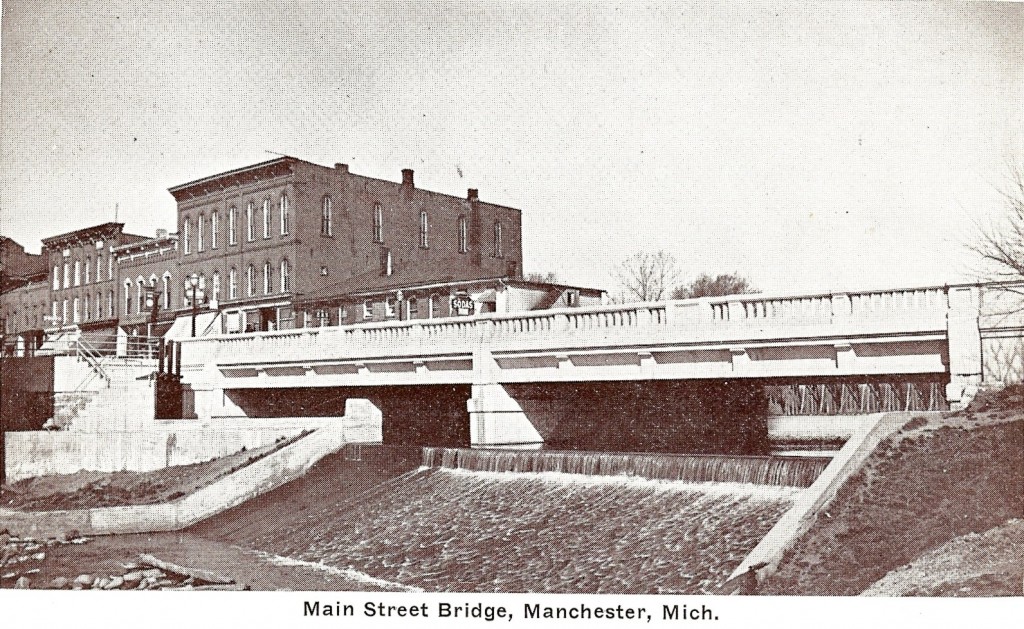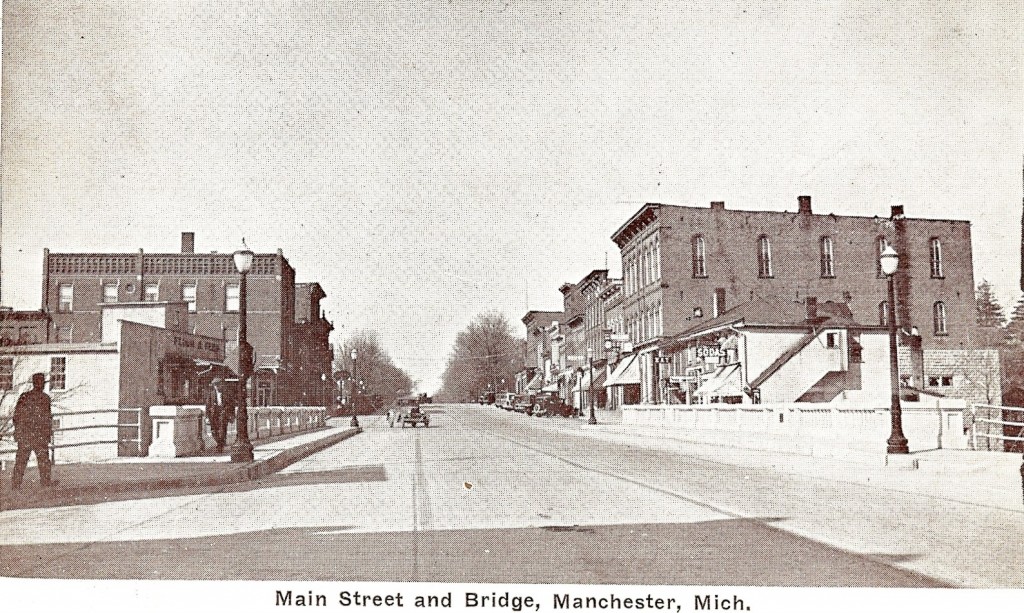The Five Lives of the Main Street Bridge, Part Four of Five
Bridge #4 –The 1929 Concrete and Steel Bridge
Mat Blosser was still editor of the Manchester Enterprise in 1928, to see technological change render his “forever” iron bridge obsolete. The mid-1920s saw a boom in automobile driving for pleasure, and families taking weekend trips in their cars to enjoy rural settings away from the big cities. Much like Manchester officials and businesses had welcomed the railroad in the 1870 boom times to bring traffic into town, they promoted themselves in the boom time 1920s as a place for families to come to in automobiles.
This was much more inviting if the roads leading to them were paved. The State of Michigan obliged by designating certain roads as State roads, and in 1926 designated what is now Austin Road between Saline and Napoleon as M-11, running through downtown Manchester. Paving of Main Street downtown, and for about ½ mile on either side, was completed in 1928, as well as Ann Arbor Street. On October 24, the Village held a “Manchester Street Festival”, to celebrate completion of the first mile of paving in the village, with a pavement dance, street carnival, masquerade, and corn harvest festival. Various bands were present, and Governor Green was invited. A sudden severe thunderstorm washed out the event, which moved to the new Emanuel Church Fellowship Hall where a good time was had by all.
It was planned to pave the entire route of M-11, but the Depression and World War II delayed completion until 1948. Manchester also joined in discussions with Adrian, Clinton, Chelsea and points north during 1927-28 about a new north-south route, and several public meetings were held, but this route was not to come until the 1950s-1960s with M-92, later designated M-52.
The iron bridge across the Mill Pond was too old and narrow for two-way automobile traffic by State road standards, and the State made plans in 1928 to replace the bridge with State funding. On May 31, 1928, William Hoffer, owner of the mill, received a notice from Lansing regarding putting gates in his mill flume, in preparation for lowering the mill pond water level to allow construction of concrete abutments. The State issued specifications for a concrete and steel bridge, with two 55-foot spans, reinforced concrete abutments and footings, one concrete pier, a steel girder type deck with reinforced concrete floor and concrete wearing surface, concrete spindle railings, a 40 foot roadway, and two 6 foot sidewalks.
On September 13, 1928, the Townsend-Dailey Co. of Ypsilanti received the contract, and on November 29 began removing the old bridge and constructing the west abutment. The new bridge was considerably longer than the old bridge, and detours to the Boyne (Duncan) Street bridge began for vehicles. At first, pedestrians could still use the remaining portions of the iron bridge, but by mid-December were told to also use the Duncan Street bridge to travel about town.
Outrage quickly developed, and demand ensued for a temporary pedestrian bridge by the dam. The Enterprise story read “Citizens bake Supervisor Merithew in this public necessity. The town businesses are split in half, population split in half, east vs. west, churches and post office on one side, school on the other, etc.” The Council reversed itself and authorized Clark & Son to build a temporary footbridge over the lower apron of the dam, six feet wide and six feet above the river with steps and railings, for the duration of the construction.
The construction of the new abutments and pier dragged on for months, with several week-long delays caused by unusual rains and snow melt flooding of the mill pond. A large cofferdam was constructed so that iron dredges could dig down to the rock foundation. The old stone abutments for the iron bridge built in 1886 had to be chiseled away by hand, as explosives were not allowed in the center of the village. Blosser praised the endurance, hard work and repeated efforts of the concrete crews whose “work will stand for ages and our children’s children will bless the builders.”
On May 7, 1929, the first concrete abutment on the west side was completed and exposed, and by June 20 the center pier was completed. Unfortunately, issues of the Manchester Enterprise for 1929 are not available after July, so we could not trace the further work, other than the bridge was completed and opened in October 1929. The bridge was often referred to as the “American Legion Bridge”, due to a marker on its east side, reading “Dedicated to the memory of the Soldiers, Sailors and Marines of the Civil, Spanish and World Wars.”
Figure 5 shows a side view of the new bridge in 1929, and Figure 6 shows a view down the street.
Click HERE to read the conclusion, Part 5 of The Five Lives of the Main Street Bridge.












You must be logged in to post a comment Login